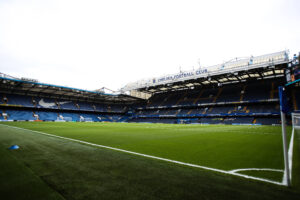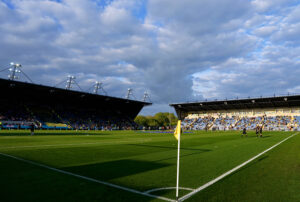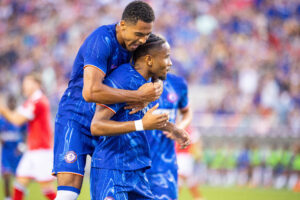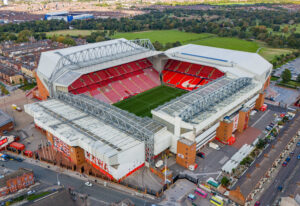When you don’t seem to have much of a future, it’s easier to live in the past, and that is probably truer of Arsenal than any other football club, precisely because its past is so glorious and its future so uncertain. The announcement this week of the imminent release of the “Arsène Wenger: Invincible” documentary is the latest celebration of that glorious past and in particular its greatest modern peak. But there will be another on Monday night when Patrick Vieira will return to Arsenal as the Crystal Palace manager and Arsenal fans will be reminded of the greatness of one of the club’s finest ever players.
Patrick Vieira Arsenal Return is a Reminder of a Quietly Colossal Player
Vieira An All-Time Arsenal Great
That Vieira is an all-time Arsenal great, one entirely worthy of inclusion in any all-time Arsenal 11, is indisputable; all that is open to question is the exact nature of that greatness. In a piece written during the pandemic-caused cancellation of almost all football last year, it was argued that only the talisman of the all-conquering 1930s side, Alex James, surpasses Vieira as Arsenal’s greatest ever midfielder.
And even that assertion is open to debate, not least because James was undeniably more of an inside forward/number ten than the commanding five-star midfield general that Vieira was at his height.
Suffice to say that, alongside Liam Brady, Vieira and James would comprise an all-time Arsenal midfield capable of giving any other club’s all-time fantasy midfield a serious run for their money.
Buying Him Was Wenger’s First Masterstroke
Vieira was not Wenger’s first signing at Arsenal – that honour belongs to Rémi Garde, who would go on to become Vieira’s central midfield understudy/injury replacement, at least for a while – but he was undeniably Wenger’s first significant signing at the club.
His arrival at Arsenal from AC Milan was the best possible evidence that a manager who was largely unknown in England before his arrival, including among the Arsenal players he was now managing, actually knew what he was doing.
As Nick Hornby and many other Arsenal fans have joked, initially they thought, “We could have signed Jason McAteer instead!” Instead, they soon discovered that Wenger had signed a central midfielder who combined physical presence with sublime skill, and who would go on to be the bedrock of the great Arsenal sides of Wenger’s first decade in charge.
Vieira formed at least two magnificent midfield partnerships at Arsenal in that period. The first was with Emmanuel Petit, which was a left-foot/right-foot central midfield combination that was translated into the French national side in time for the World Cup glory of 1998 that swiftly followed Wenger’s first double at Arsenal.
The second was with Gilberto Silva, another World Cup winner whose greater emphasis on defence finally gave Vieira the free rein to unleash all his incredible attacking instincts. But the truth was that Vieira invariably excelled alongside whoever he was paired with in Arsenal’s midfield, from Rémi Garde to Edu to a young Cesc Fabregas.
That was because, at his best, he was almost a one-man midfield, just as Sol Campbell and Thierry Henry, the other two key components of the Invincibles side, were almost a one-man defence and one-man attack respectively.
But Selling Him Was Wenger’s First Major Mistake
It is to be hoped that in the ‘Invincible’ documentary Wenger finally sheds some light on why he eventually sold Vieira to Juventus in 2005 when he was just a year short of a full decade in the Arsenal midfield and only a month or two on from scoring the winning spot-kick in the penalty shootout at the end of the 2005 FA Cup final against Manchester United.
Ostensibly, it was because Vieira had finally begun to experience long-lasting injury problems, after appearing nearly impervious to serious injury in his first five or six seasons at Arsenal. In the short term, it appeared to be a typical Wenger masterstroke, as Vieira’s replacement in midfield, Fabregas, completely outplayed Vieira when he returned to Highbury with Juventus in the Champions League.
In the longer term, however, it is arguable that the sale of Vieira was the first false step that Wenger made at Arsenal, one that would soon be followed by more than a decade of far worse mistakes before he finally left the club in 2018.
Wenger himself once called Vieira “the umbilical cord between the team and the fans”. If anything, however, Vieira was even more important than that on the field, where he was effectively Arsenal’s spinal cord for nearly a decade, knitting together, seemingly effortlessly, the defence and the attack, precisely because he was as capable of playing as a third centre-back as he was at being an attacking number ten.
More than a decade and a half on from his departure from Arsenal as a player, the Gunners have still not satisfactorily replaced him. Indeed, it is now increasingly evident that they never will, because players such as Vieira are almost literally irreplaceable.
Vieira Returns as the Crystal Palace Manager
Now, of course, Vieira is returning to Arsenal as a manager, with Crystal Palace, having replaced the retiring Roy Hodgson this summer. Initially, some Palace fans feared that this was another vanity appointment by Steve Parish, the club’s chairman, similar to the utterly disastrous appointment of Frank de Boer in 2017. The Dutchman, of course, only lasted for four league games, all of which were lost, before he was fired and Hodgson brought in.
So far, Vieira has only been in charge of Palace for seven league games, and he has won only one of those seven. However, that was a scintillating 3-0 win over Tottenham Hotspur, when Spurs were top of the league after an unbeaten start to the season, and alongside a succession of combative draws. They have been reassured that Vieira, having played for so long in the Premier League, knows all about its unique physical demands, but in addition, his Palace team have already played so well, in direct contrast with the last dog days of Hodgson’s side, that they are genuinely looking forward to the trip to The Emirates.
Vieira himself was a master of the counter-attack, the man who usually launched the deadly attacks by an Arsenal forward line of Henry, Wiltord, Pires et al that Henry Winter famously said should be the French 4 x 100 metres Olympic relay team.
As a result, it is unsurprising that his Palace side are already showing signs of being effective counter-attackers themselves, with the pace and wizardry of Wilfried Zaha (who has been a regular tormentor of Arsenal sides in the past, perhaps in revenge for their absurdly preferring to buy Nicolas Pepe rather than him) now being added to by Vieira signings such as winger Michael Olise and striker Odsonne Édouard.
Consequently, the Palace match will be a key one for Arsenal and in particular their manager, Mikel Arteta, one of the many men with whom Arsène Wenger tried and ultimately failed to replace Vieira on the pitch. Arsenal and Arteta may have steadied the ship after their disastrous start to the season, but that ship still looks perilously close to listing or even sinking at any time.
As a result, Arteta knows that if his side allow Vieira’s Palace to attack or counter-attack them too easily on Monday, they are vulnerable to yet another defeat. And if that happens, then Vieira will not only be applauded when he goes to the away dugout at The Emirates. Indeed, he might just leave the stadium with cries for him to replace Arteta as the Arsenal manager ringing in his ears.
Main Photo
Embed from Getty Images






